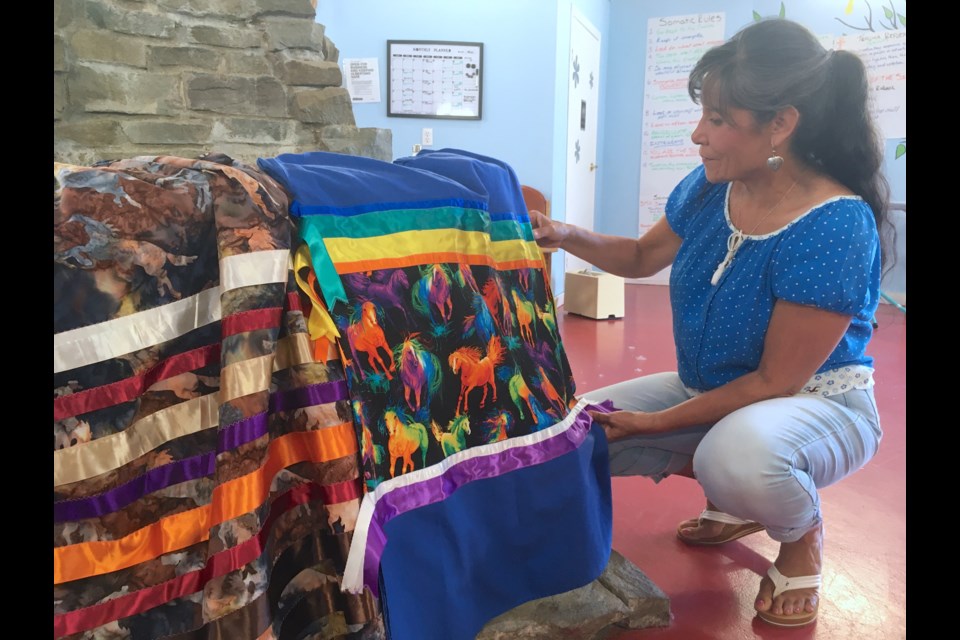SUNDRE – For many of us, the clothes we decide to don on our backs are largely a reflection of the fads and trends that appeal to us, such as a shirt boasting the name of a band or brand logo that resonates with our stylistic preferences.
But for First Nations, Métis and Inuit individuals who hand craft their own ribbon skirts, the garment also offers a sense of pride alongside a cultural and spiritual connection with the natural world.
Mountain View Moccasin House sponsored on Saturday, June 10 a ribbon skirt making workshop at the Sundre & District Museum that was partly funded by Family & Community Support Services in concert with Greenwood Neighbourhood Place Society.
Pam Piché Lashmore, a rural Métis resident of the Water Valley area whose Métis father Harvey Piché once called Sundre home, said she has sewed pretty well her whole life. Lashmore imparted with the Albertan some insight into the cultural significance of ribbon skirts among First Nations, Métis and Inuit people.
“I wear skirts a lot,” she said during a conversation at the Sundre museum’s roundhouse, which regularly provides space to host activities and workshops of all kinds whether for Canada Day, Culture Days, or in this instance, National Indigenous Peoples Day, which this year is being observed countrywide on June 21.
“The reason why I wear skirts is when I’m at home, I will wear my moccasins and I will wear my skirt and I will walk through the bush,” she said.
“As Indigenous women, when we wear our skirts, we walk through the bush – our skirts are long and they drag on the ground. And as they drag on the ground, they’re gathering up the medicines of the plants,” she said.
“And I wear my moccasins because it will absorb that medicine through my moccasins and into the soles of my feet, and then I’ll go into my home and I will share that medicine as I do my daily chores and as I go about my day. As women, we were given the gift of taking care of the home,” she said.
“And that is one way that we can take care of our home is when we wear our skirts, by sharing that medicine in our home everywhere we go,” she explained.
Making ribbon skirts also offers a chance to bring people together and further fuse a community that much closer.
“When women come together, there are great things that happen,” she said, adding a “really nice energy” permeates a place where women gather to combine and coordinate their collective talent.
“It’s the women that hold the family together, and if you have strong women, you have strong families. If you have strong families, you’ll have a strong community,” she said, adding that men play an equally important part along that path.
“We need our men to help us to do that,” she said.
Over the course of the past roughly 15 to 20 years, there seems to have been a resurgence of interest in making ribbon skirts from young women seeking to rediscover their roots, she added.
“I am seeing more young women wearing ribbon skirts than I’ve ever seen before, and they are so proud of what they do in their accomplishments,” she said.
“That is good medicine right there in itself.”
Re-introducing today’s youth to aspects of their ancestors’ traditions is a way to not only reconnect them with but also reclaim their roots.
“I really do,” she said without hesitation when asked if she considered the opportunity to offer such lessons a part of reclaiming her own history.
“Especially with our young ones; our young ones are the ones that are the future,” she said, adding today’s youth will carry that legacy and knowledge onto tomorrow.
That is largely what motivates her to get involved in such initiatives, she said when asked, adding ribbon skirts are not exclusive to any one particular demographic.
“Anybody can wear them,” she said.
Humanity is comprised of four main tribes: the Black, the Red, the White and the Yellow, she said.
“We’ve got to learn to get along. We’ve got to learn to stop judging one another and we have to share our culture; we live together. We even marry each other,” she said.
“It doesn’t matter what part of the world you’re from, what your background is,” she said. “If you want to wear a ribbon skirt, you’re more than welcome to. And that’s our teachings.”
There is just one catch.
“They need to be worn with respect and they need to be worn with pride,” she said.



